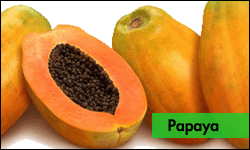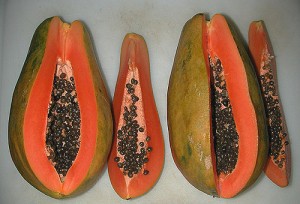Back to > Major Fruits | Minor Fruits | Underutilized Fruits
![]()
 |
|
|
Introduction:
Papaya (Carica papaya) is a tropical fruit having commercial importance because of its high nutritive and medicinal value. Papaya cultivation had its origin in South Mexico and Costa Rica. Total annual world production is estimated at 6 million tonnes of fruits. India leads the world in papaya production with an annual output of about 3 million tonnes. Other leading producers are Brazil,Mexico,Nigeria,Indonesia,China,Peru,Thailand and Philippines.
Origin: The papaya is believed to be native to southernMexico and neighboringCentral America. It is currently cultivated inFlorida,Hawaii, Eastern British Africa,South Africa,Sri-Lanka,India, Canary Islands,Malaysia andAustralia. It is now present in every tropical and subtropical country.
History: The history of papaya spread was initiated approximately in 1500, when the Spanish conquerors carried seeds to Panama and Dominican Republic. Papaya was first described in 1526 by the Spanish chronicler Oviedo, who found it first on Panamanian and Colombian coasts. The fruit was rapidly propagated in the tropics, most likely due to the abundant and highly viable seeds. The crop has adapted quite well to tropical areas with fertile soils and abundant rainfall. During the following century Spanish and Portuguese sailors took the seeds to the Phillipines, Malaysia and India. For 1600 the fruit had been produced in warm regions of South and Central America, Southern Mexico, the Antilles, Bahamas, Bermuda y Florida. In the same century pawpaw seeds were taken from India to Naples in Italy. The crop reached Hawaii between 1800 and 1820. Until 1900, papaya seeds were taken to Florida, probably from Bahamas’ plantations. The Solo variety has been cultivated in Hawaii since 1911, probably brought from Barbados and Jamaica. The first seeds of the Maradol 1 variety were introduced into Mexico in 1978, through CONAFRUT, in Xalapa, Veracruz.
 |
 |
Economic Importance: Fruit is a rich source of vitamin A and C. It has a high nutritive and medicinal value. Papain prepared from dried latex of its immature fruits is used in meat tenderizing, manufacture of chewing gum, cosmetics, for degumming natural silk and to give shrink resistance to wool. It is also used in pharmaceutical industries, textile and garment cleaning paper and adhesive manufacture, sewage disposal etc.
Major papaya producers areBrazil,IndonesiaandIndiathat export the fruit to many countries, including theUnited Kingdom.
Reference:
- Chong, S.T., R. Prabhakaran and H.K. Lee. ISHS Acta Horticulturae 787: International Workshop on Tropical and Subtropical Fruits.
- Lamberts, M. and J.H. Crane. 1990. Tropical fruits. p. 337-355. In: J. Janick and J.E. Simon (eds.), Advances in new crops. Timber Press,Portland,OR.
- Morton, J. 1987. Papaya. p. 336–346. In: Fruits of warm climates. Julia F. Morton,Miami,FL.
